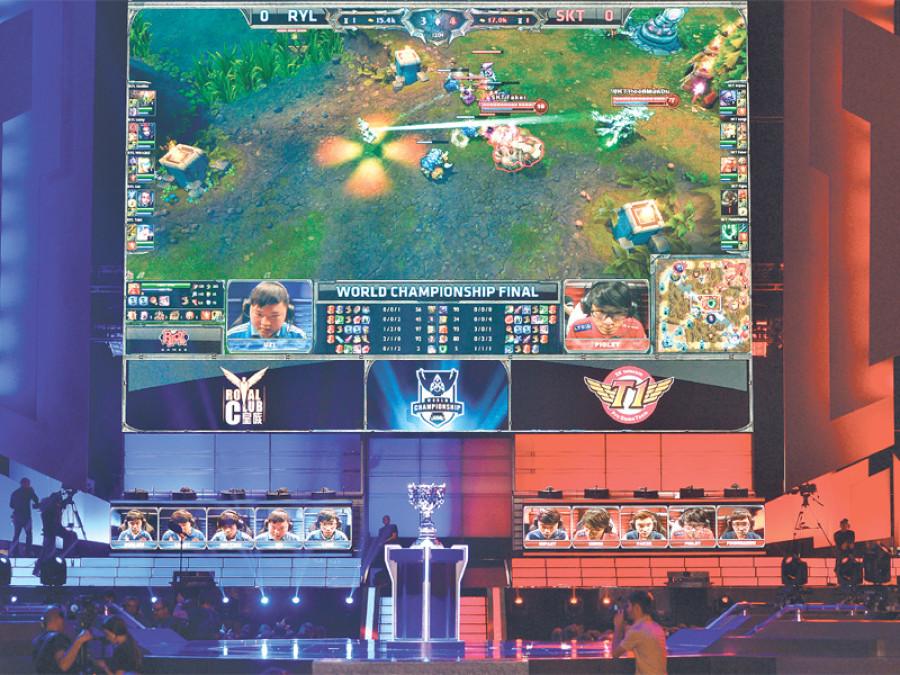Entertainment
The eSport fever grips Nepali gamers
Crimson Frontiers debuts alongside Hive Gaming Zone—bringing a gaming event that promises Nepali gamers what is long overdue
Prazon Parajuli
It was in early 2000s that netizens experienced something that would change the whole discourse of video gaming. It was eSports: the abbreviation for Electronic Sports. Even though it is popular among mainstream gamers, what eSport actually entails has been a topic of curiosity to others—what does playing an eSport actually entail?
To put it simply, eSport are competitive tournaments held among professional gamers who compete in various single or multiplayer video games. These gaming events feature the best competitive gamers who battle against each other to claim the winning title, while hundreds and thousands of spectators stand witness. In the last decade, the number has gone up significantly to millions worldwide and the eSport phenomenon has grown towards being a multi-billion industry.
Many argue whether playing video games should be considered an actual ‘sport’ or not. Wikipedia describes sports as, “Sport (UK) or sports (US) are all forms of usually competitive physical activity or games which, through casual or organised participation, aim to use, maintain or improve physical ability and skills while providing entertainment to participants, and in some cases, spectators.” ESport players and fans could care less about the terminology, as long as the games are extremely rewarding and garners global recognition. Just last year in 2015, Valve Corporation hosted its fifth iteration of annual Dota 2 Championship which boasted the prize pool of US $18 million and broke the record set by their previous iteration as the highest prize pool in eSport. Just to give you an idea, Golf’s US Masters handed out US $10 million the same year. These athletes that practice the game day in and day out to master the skills and possess top notch reflexes also get paid in six figure salaries, most still in their teens and early 20s. Of course not everyone makes the cut but those who do surely get rewarded and achieve celebrity status in the gaming community. You don’t believe me? Ask Sumail “Suma1L” Hassan Syed of the popular Dota 2 team Evil Genuises, who made a name for himself at just an age of 15 by securing first place for his team in the Dota Asia Championships winning $1.2m, and repeating the success later that year in the most prestigious Dota 2 tournament in the world The International 5 and bringing in a $6.6m prize pool to his team in 2015.
E-sport has also been recognised by many universities in the US, some even offer scholarships to professional gamers. In Sweden, there are schools with eSport in their curriculum that are aimed at improving reflexes, decision making ability, communication and tactical approach among students.
Now, coming to the question that is on everyone’s mind right now: What is the current state of eSport in Nepal? The answer is somewhat bittersweet. Although we do see a handful of eSport events happening every year, with a decent prize pool, there is still a long way to go. The progress has been sluggish, but it is surely not in the same place it was a decade ago, when tournaments were only held by local cyber cafes and gaming hubs in small scale just to promote gaming among the purists; times have changed for the better and now the gaming community in Nepal measures in thousands, if not more. The popularity of eSport has gone up tenfold globally in recent years and there are more multi-national brands dedicated to this industry than ever. With these factors in regard it is safe to assume that the potential competitive gaming holds in Nepal still remains untapped.
Cyber cafes and console gaming centres are packed with gamers on a regular basis who spend anywhere from four to eight hours a day playing competitively. The three most popular competitive games in Nepal right now—Dota 2, Counter Strike: Global Offensive and FIFA 16—manage to bring in over 600 competitors collectively at major events. Yet, the scenario is plagued by poor management and high expectations that are not met, but these events take place only annually, giving little boost to the platform to grow.
Nepali eSport organisations such as Myktm and Ngamers have been in the game for a while, their efforts clear in helping develop the competitive gaming scene of Nepal. Come March-April, Crimson Frontiers debuts alongside Hive Gaming Zone and are finally bringing a gaming event that promises Nepali gamers what is long overdue, with features such as live streaming with commentary, first official ranking of eSport teams of Nepal along with daily updates and video highlights online—sounding nothing like any event that we have seen yet, locally. With names such as the popular cyber café, Power-Play and the console gaming centre Hive Gamespot associated with it, gamers are naturally expecting a lot. If they deliver, the event could well cement itself as the biggest one in Nepal yet, paving a transformation in the gaming community itself, but only time can tell.




 6.12°C Kathmandu
6.12°C Kathmandu










